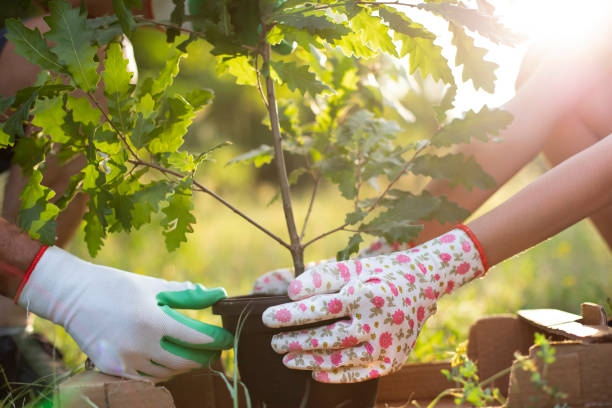Fall is the Perfect Time to Plant Trees for a Thriving Landscape

Photo: istock
Get Growing with Mickey Rathbun
The following column appeared originally in the Daily Hampshire Gazette.
It is often said that the best time to plant a tree is 20 years ago. But for those of us who aren’t able to time travel, it’s never too late to start adding trees to our landscapes. I stopped by Sugarloaf Gardens in Sunderland recently to see what sorts of small trees they had in stock and asked the owner, Dan Ziomek, to show me around. Ziomek assured me that fall is an excellent time to plant trees because cooler, wetter weather makes for less stress on the plants and less need for watering. “Just be sure to plant them early enough to let them establish their root system,” he said. The UMass Extension Service recommends getting trees in the ground by mid-October.
Ziomek takes obvious pride in his nursery’s offerings. One of his favorite small trees is seven-son tree (Heptacodium miconioides), which he believes deserves to be better known and more widely used. The plant is native to China (its name is a direct translation of its Chinese name) and was discovered in 1907 by a British plant collector named Ernest Wilson and brought to Boston’s Arnold Arboretum. As Ziomek made clear, there’s nothing not to like about this plant. It tolerates most any soil type, from clay to gravely sand. It sends forth its clusters of delicately scented white blooms in late summer, providing valuable nourishment to all sorts of bees, butterflies and other pollinators at a time when most nectar-rich flowers have called it quits for the season.
Seven-son tree provides visual interest year-round. Once its flowers have finished blooming, the pale pink sepals remain, giving the appearance that it’s in bloom again. In the fall, the sepals turn bright red as the foliage turns yellow, orange and crimson. Its smooth light brown bark exfoliates in strips, making a striking picture in late fall and winter after it sheds its leaves. It can be grown on a single trunk or multiple stems as a large shrub. Any sunny spot in your garden will suit this plant just fine.
And what about redbuds? John Kerry, when running for president back in 2004, is famously misquoted as saying, “Who among us does not love NASCAR?” (He actually said, ““There isn’t one of us here who doesn’t like NASCAR and who isn’t a fan.”) I would add to that, “Who among us does not love redbuds?” I aspire to have a redbud grove. My plan got off to a rough start several years ago when a neighborhood boy who was helping me in the garden hacked down my inaugural redbud by mistake. (The dead dogwood was what I asked him to get rid of.)
I have always loved redbuds for their early pinkish purplish flowers, a welcome sign of spring’s arrival. The Eastern redbud (Cercis canadensis) is native to the eastern half of North America and offers a valuable early source of nectar and pollen for bees, butterflies and hummingbirds. Songbirds enjoy its flowers and seed pods, and caterpillars and other insects that feed on redbuds also provide food for birds.
Sugarloaf Gardens has an impressive assortment of redbuds with eye-catching foliage in a wide range of colors. An excellent choice for a small garden is “emerald gem.” It has double flowers and lovely heart-shaped leaves that start out burgundy and turn a rich green as they mature. “Green machine,” another compact variety, is a vigorous grower that forms a dense, rounded crown. “Golden falls,” a compact upright weeping redbud, has lovely golden-yellow leaves; “ruby falls,” another compact weeper, sports rich maroon foliage. A larger, variegated option is “alley cat,” whose green leaves are boldly splattered with splotches of pale green and ivory. The tree was so named because it was first discovered growing wild in an alley in Kentucky. “Black pearl” is prized for its dark purple foliage and purple flowers. My favorite discovery is called “flame thrower.” Its stunning foliage is a mix of crimson, green and yellow.
One other interesting small tree Ziomek showed me is a relatively new Kousa dogwood hybrid. When regular dogwoods became vulnerable to anthracnose and dogwood borer in the 1970s, Dr. Elwin R. Orton Jr. of Rutgers University, set out to create a hardier, disease-resistant dogwood. His highly successful Cornus x rutgersensis is a cross between the native flowering dogwood (Cornus florida) and the Kousa dogwood (Cornus kousa), a native of East Asia. The hybrid has longer bloom times than the Kousa and offers a greater variety of colors. I might replace my dead dogwood with one of these beauties.
The weather is still hot but the days are getting shorter. There’s plenty of time left to plant some trees. In just a few years — you won’t have to wait 20 — they’ll be magnificent.
Mickey Rathbun is an Amherst-based writer whose new book, “The Real Gatsby: George Gordon Moore, A Granddaughter’s Memoir,” has recently been published by White River Press.
